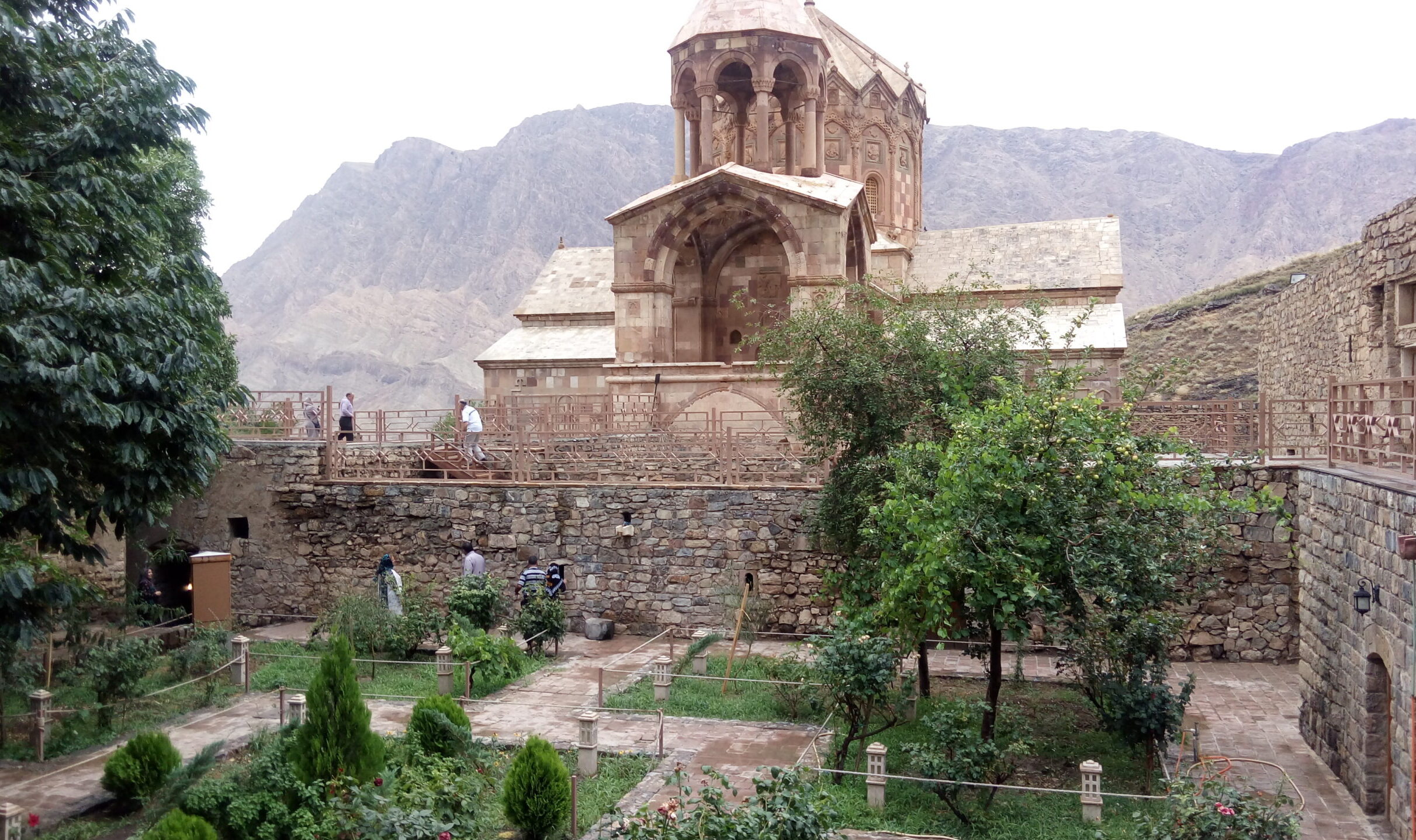Iran’s Christian Heritage
An Iraq-style war would imperil the country’s Armenian Christians.

Having walked the ancient stone paths of St. Thaddeus, St. Stepanos, and the Shepherd’s Chapel in northwestern Iran on a recent trip, I’ve witnessed the enduring spirit of these Christian heritage sites. Their intricate carvings, frescoes, and sacred chambers, nestled in the rugged cliffs of a region inhabited by Azerbaijanis, Kurds, Armenians, Assyrians, and Persians, resonate with centuries of faith, community, and against-the-odds survival.
Built by Armenian Christians, these sites have weathered Mongol invasions, Ottoman sieges, and the rise and fall of empires. In the early 20th century, they sheltered those who fled the Ottoman genocide. Today they remain vibrant centers of worship, with hymns echoing through ancient chambers, drawing Armenian pilgrims from around the world and Muslim visitors alike. The undisturbed churches symbolize a broader social-political reality: Iran’s roughly 200,000 Armenians, concentrated mostly in Tehran, Isfahan and Tabriz, enjoy constitutional protections, including parliamentary representation, Armenian-language schools, and cultural autonomy.
Yet today, they face a grave peril arising from a combination of factors.
One is the risk of American and Israeli military strikes on Iran’s nuclear facilities, which would likely lead to another “forever war” and unleash chaos akin to the devastation of Iraq’s Christian communities in the ill-fated U.S. invasion of that country in 2003.
That invasion, sold as liberation by neoconservative ideologues who dominated the George W. Bush administration, irreversibly decimated one of Christianity’s oldest communities. In Mosul, where the Aramaic language—Jesus’ own mother tongue—once thrived, churches like the Syriac Catholic Church of Our Lady of Salvation were bombed, their clergy abducted, and their congregants exiled. The invasion—rooted in hubristic assumptions that democracy would flourish in Iraq in the wake of a regime change—left Christians defenseless against Al Qaeda and ISIS. Iraq’s Christian population, once vibrant, has dwindled by roughly 80 percent—from more than 1.5 million before the invasion in 2003 to some 250,000 people remaining today.
As calls for war on Iran resurface in Washington, St. Thaddeus and St. Stepanos stand as warnings: reckless intervention risks reducing Iran’s churches, and the lives of the Armenian Christians who attend them, to ruins.
The risk of devastation is heightened by simmering international tensions in the region, where the ambitions of Azerbaijan, Turkey, and Israel converge in a dangerous mix. A U.S.-Israel war on Iran could cause the tensions to boil over, further endangering Iran’s Armenian Christians.
Baku’s expansionist regional designs constitute one major threat. While the wars between Armenia and Azerbaijan in the early 1990s, following Soviet collapse, saw atrocities committed by both sides, Azerbaijan—with Turkish and Israeli support—emerged victorious in the early 2000s. Baku, emboldened by its 2023 ethnic cleansing of 120,000 Armenians from Nagorno-Karabakh, fuels pan-Azerbaijani rhetoric claiming Iranian territory. While not a formal goal of Azerbaijan’s foreign policy, state institutions and official media promote the notion of a “South Azerbaijan” containing territory from Iran’s northwestern regions and host Azerbaijani separatists exiled from Iran. Such belligerence, though for now merely rhetorical, lays the groundwork for territorial expansion should the Iranian government be destabilized.
Turkey, which arms Azerbaijan and denies the 1915 Armenian genocide, also seeks to expand its regional footprint, with President Recep Tayyip Erdogan occasionally positioning himself as a protector of all the region’s Turkic peoples, including Azerbaijanis in Iran. At present, Iran’s Azerbaijani and Armenian communities coexist in relative harmony, but a breakdown in the social order could change that, and the Armenian community would be made more vulnerable to the horrors of ethnic conflict if Turkey intervened.
Israel, Azerbaijan’s top supplier of advanced weaponry, aims to fracture Iran along the ethnic lines, and Iranian leaders fear Jerusalem could work to inflame pan-Azerbaijani nationalism, undermining Tehran from within its own borders.
This “balkanization” strategy has been advocated by neoconservative DC think-tanks and pundits like Brendan Shaffer of the Foundation for Defense of Democracies, who has been on the payroll of Azerbaijan’s state oil company SOCAR and teaches in Azerbaijan’s state-run Diplomatic Academy. Another such pundit is the Hudson Institute’s Mike Doran, a George W. Bush-era national security official who promotes Azerbaijani irredentist claims on Iranian territory. Shaffer authored a paper in 2021 calling on the U.S. government to use non-Persian ethnic groups, notably Azerbaijanis (the biggest of them) to increase pressure on Tehran. In its most recent iteration, this strategy expresses itself in a push to include Azerbaijan in the Abraham Accords, a proposal explicitly framed as an effort to contain Iran and entangle the U.S. in yet another alliance in the Middle East.
A U.S.-backed war on Iran could see these forces mobilize to carve a “Greater Azerbaijan” from Iran’s northwest. Azerbaijan’s actions in recent years offer a grim preview of what that could mean for Iran’s Armenians. Baku has systematically obliterated the Armenians’ cultural presence in Azerbaijan through war, propaganda, and state-sponsored vandalism.
As I stood last week beside the Araxes River, a narrow body of water separating Iran from Azerbaijan, I was reminded of the ongoing erasure of Armenian culture right across the border in the Nakhchivan region of Azerbaijan, where a priceless Christian heritage lies in ruins. Khachkars (intricate Armenian cross-stones) have been systematically destroyed, churches like the Ghazanchetsots Cathedral in Shusha have been desecrated, and Armenian cultural sites have been falsely rebranded as “Caucasian Albanian” to rewrite history. This eliminationist playbook, coupled with Baku’s glorification of wartime atrocities, signals the danger facing St. Thaddeus and St. Stepanos if U.S. policies enable the destabilization of Iran.
To prevent that from happening, Washington should do more than talk about religious freedom and the protection of Christians worldwide, a goal championed by multiple Republican administrations—it should also craft policies that reduce threats to Iran’s Armenian community. That means purging the GOP of the ruinous neoconservative influence which is largely responsible for the disaster in Iraq and now pushes to repeat it, on a much larger scale, in Iran. The MAGA and libertarian wings of the Republican Party, represented by figures like Tucker Carlson, Steve Bannon, Rep. Marjorie Taylor Greene, and Sen. Rand Paul, among others, oppose escalation with Iran. Their skepticism of intervention, born of lessons drawn from the failed Iraq war, offers a chance to rethink U.S. policy in the Middle East.
Negotiating a stringent, but realistic agreement that forecloses Iran’s pathways to nuclear weapons—which, according to the assessments of the U.S. intelligence community, Tehran is currently not seeking anyway—would not only serve U.S. interests, bolstering stability in the Middle East, but also safeguard one of the region’s surviving Christian communities. At the same time, the U.S. should communicate to its partners and allies in Turkey, Israel, and Azerbaijan its strong opposition to any ethno-nationalist, irredentist schemes that would wreck the region.
At St. Thaddeus and St. Stepanos, rising above the Araxes, hymns still sound, echoing those silenced in Nakhchivan and Shusha on the other side of the border. Let them guide us. In peace, not war, lies redemption.
The post Iran’s Christian Heritage appeared first on The American Conservative.

